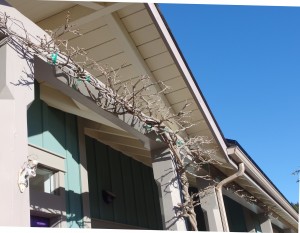Pruning the Wisteria
I spent the morning pruning the wisteria vine that grows along our front porch. Up and down the tallest stepladder, leaning over the porch beam to reach the longest stems, I snipped and thinned. Each time I do this task, I remember with gratitude the workshop I attended years ago at the Elizabeth F. Gamble Garden in Palo Alto. “Be ruthless if you want flowers,” the instructor said. Ruthless I am. Otherwise the new growth pushes between the porch beam and ceiling, wraps itself round the lamp above the front door and seeks to enter the house itself.
Wisteria is not for the faint of heart. In May, as soon as the magnificent double purple flowers have bloomed and dropped, the new stems start growing. If left their own devices, they can reach ten feet in a year. As soon as they threaten to strangle visitors at the front door, I whack back as many as I can reach with my pole pruner. I may have to do this several times during the summer. In fall I haul out the big stepladder and take back all the foliage to somewhere near its supporting wire. However, in our mild coastal climate, the leaves don’t drop until well into the winter. It’s only then that I can see the structure I have trained over the years and can scrutinize each branch that sprouts from the main stem, looking for crossed twigs, dead wood, and stems facing back toward the house.
It’s a strenuous task. But when it is done, the prunings composted and the porch swept, there’s such a sense of satisfaction in looking up at the vine and seeing the shape of it against the house.

Look forward to seeing the structure of your handiwork but know I will be too late for the blossoms!
I can empathise with this, Maureen. With the temperate New Zealand climate, I usually have a space of two months or so to climb ladders, strand on porch surrounds or clamber on the roof, for the annual wisteria pruning. Our wisteria is old–probably planted in the 1920s or 1930s—and very substantial, with a base circumference of 38″ (96cm). One thing you might not need to consider in Northern California are stem-boring wetas (a scarey insect for the unitiated), but you might have local equivalents.